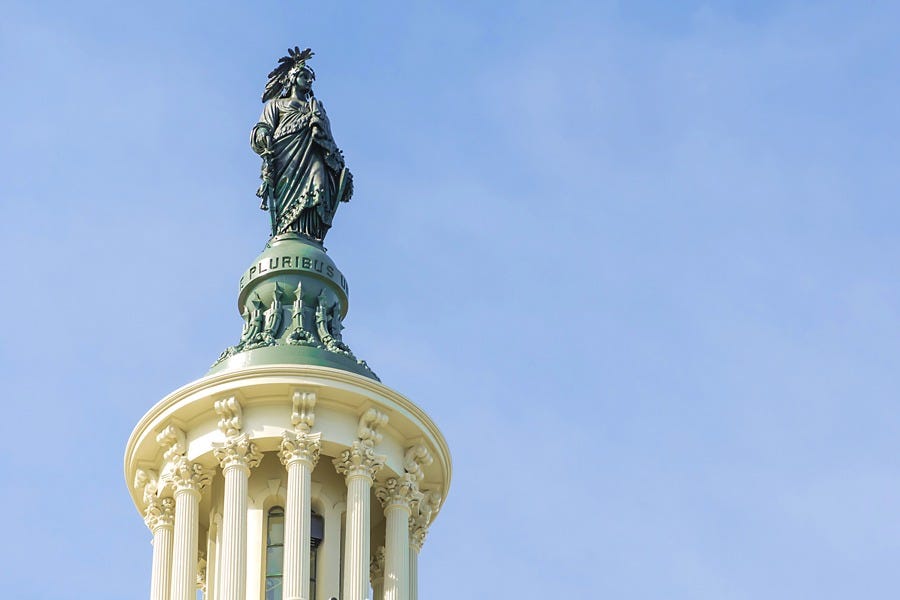{J} 26: What a Monument Means
A visit to the monument to Cuauhtémoc, the first man to resist the foreigners
“Walk along this Reforma Causeway at all hours of the day, if you can't get any farther from the city. Haven't you noticed how the city is marching westward? ...Mexico seems to be detaching itself and moving away from the place where the conquistadors left it... ”
—Manuel Gutiérrez Nájera, August 21, 1887, at the inauguration of the Statue of Cuauhtémoc
When an eagle folds in its wings and dives at its prey, that’s what Cuauhtémoc means: Descending Eagle.
It was Cuauhtémoc who led the Aztecs against the conquistadors after the death of Montezuma, who had welcomed Cortez. It was Cuauhtémoc, some say, who threw the stone that fatally wounded Montezuma, who fell down the steps of the great pyramid, bleeding from his head. And it was Cuauhtémoc who Cortez finally captured and tortured—covering his feet in oil, lighting those feet on fire, and then later hanging him from a pochote tree. And today, after all of that, it’s Cuauhtémoc who represents the beginning of the Mexican state.
Accordingly, he has a monument in Mexico City, right near the intersection of Reforma and Insurgentes. 1
One of the lesser-visited statues on Mexico’s widest boulevard, you’ve probably passed Cuauhtémoc on your way to see more popular attractions like El Ángel, which is famously the preferred site for tourist selfies, protests, and significant birthday parties. For some reason, nobody celebrates their quinceañera beneath Descending Eagle.
But Cuauhtémoc doesn’t seem to mind. Carved in bronze on a base of volcanic stone and marble, the last emperor of the Aztecs has been pointing his spear Spain-ward since Porfirio Díaz had him installed in 1887.2 Back then there was nothing surrounding the site but orchards and cornfields, and so there were few people to see the bronze plaques gracing two sides of the plinth: la Entrevista de Cuauhtémoc prisionero con Cortés, showing Cortez’s capture of Cuauhtémoc, and El tormento de Cuauhtémoc, showing Cortez literally setting fire to Cuauhtémoc’s feet.3 Ok, so the lack of quinceañeras makes sense.
Like all monuments, the statue of Cuauhtémoc was intended as an act of national myth building. The Aztec emperor is, in a way, the origin story for modern Mexico. According to the post-Independence, liberal idea of the country, Mexico wasn’t created by the Spaniards who occupied the territory for three hundred years. Rather, Mexico was created within a single century, beginning with Father Hidalgo’s Grito (1810, the beginning of Independence) through the expulsion of the French (1867, thanks to the efforts of Díaz and Benito Juárez) to the Juárez presidency, which ended with his death in 1872. Cuauhtémoc was important to the historia patria because he shared a common quality with Hidalgo and Juárez: they had all fought for the fatherland against an enemy from abroad.
How a country incorporates its indigenous people reveals a lot about that country’s character—or what the rulers of that country wish that character to be. For reasons which are likely obvious, you don’t find too many Native American statues like Cuauhtémoc in Washington D.C.
There is, on top of the rotunda of the U.S. Capitol Building, a statue sometimes mistaken for a native American, but which is actually a personification of what the native Americans lost: liberty. And down in the National Statuary Hall you have a statue of Will Rogers, a Cherokee who helped Americans laugh at their follies, and Sacagawea, a Lemhi Shoshone who helped Americans manifest their destiny. But as far as Native Americans in D.C. go, that’s about it.4
Rather, the grandest masonry in the nation’s capitol is reserved for the grandest Masons. Namely, George Washington, who appears at the National Cathedral sitting on a horse, at Washington Circle sitting on another horse, and in the National Museum of History without a horse but also without a shirt, looking broadchested and buff, a young country’s first chadbro. Not to mention DC’s other unmissable symbol of virility, George Washington in the form of the world’s tallest obelisk, an American erection on a hill.
The story of the United States is the story of rebellion and conquering; accordingly, monuments in the United States are monuments to the conquerors. No place for the Native American there; America looks forward, for other worlds to conquer.
The story of Mexico is the opposite: it’s the story of being conquered and then rebelling against those conquerors, protecting the patria, over and over and over again.
You might say that Mexico is doing that again, in this present moment, today.
📕 What is Julian’s?
Julian’s is a handbook for curious travelers written by Steve Bryant, who lives and works in Mexico City. Julian’s is named for his grandfather and the wordmark is designed in Frustro, a typeface inspired by the Pemrose Triangle, and which represents impossible objects—appropriate for Mexico City, which Salvador Dali once described as more surreal than his art. Come visit us soon, we’d love to meet you.
Confusingly, in Mexico City, Cuauhtémoc is not only the name of a colonia, but also the name of an alcadia that contains 34 colonias, including the colonia of Cuauhtémoc.
From first to last, the monuments were erected: Christopher Columbus (1877, since replaced by las mujeres que luchan), Cuauhtémoc (1887), The Angel of Independence (1910), and La Fuente de la Diana Cazadora (1942).
The four names inscribed on the four marble panels of the monument are Cuitláhuac, Cacama, Tetlepanquetzal, and Coanacoch, all of whom were comrades of the Aztec ruler.
It is a source of great amusement and ironic turnabout that the only privileges that Americans gave to Native Americans were licenses for casinos, which are the institutions that best describe the economy of the United States today.









Another informative post, Steve. ¡gracias!